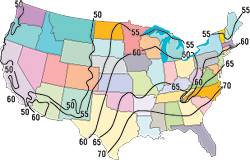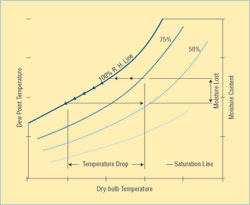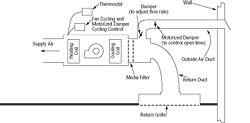Dehumidification in Hot and Humid Climates
In larger installations, there is likely to be special equipment installed that is intended solely for the dehumidification of air.
- By D. Jeff Burton, PE, CIH
- Oct 01, 2006
-----------------------------------------------------------------------------------------------------------
Abbreviations: IAQ = indoor air quality; HVAC = heating, ventilating and air conditioning; RH = relative humidity; DP = dew point temperature
------------------------------------------------------------------------------------------------------------
ACCEPTABLE IAQ in commercial buildings can often be achieved by maintaining air temperatures, relative humidities (RH), air movement, and background odors at levels that a large percentage of occupants (typically 80-90 percent) find satisfactory.
ASHRAE standards, AIHA Guideline No. 2, some building codes, and various other standards and guidelines suggest that indoor humidities should be maintained between 30 and 70 percent in occupied buildings.
What is dehumidification? This is the process of removing water vapor from the air using, for example, the mechanical cooling equipment in the HVAC system, Dehumidification of the air in buildings located in hot and humid climates (such as those located in the eastern United States during the summer months) is almost always required.
What problems can we expect to see if indoor air is too humid? High indoor humidities (about 65-70 percent) can (1) result in complaints ("it's clammy," "it feels too warm," "it smells funny in here"), (2) require lower temperatures and more air movement to achieve comfort, and (3) support the growth of microbiological agents such as bacteria, mold, and fungi. Very high indoor humidities also can adversely affect building materials (e.g., warping of wood and cracking of paint.)
Figure 1, the famous "Sterling Figure," shows the potential effects of humidity on IAQ parameters. Note that the "optimal" relative humidity is near 50 percent. (Larger bar = increase in adverse effect.)
 What are some typical sources of water or moisture that can cause high RH in typical office buildings?
What are some typical sources of water or moisture that can cause high RH in typical office buildings? Water, moisture-laden air, and water vapor can enter the building in many ways. Some typical sources are listed below.
- Hot, humid outside air entering the building through an HVAC system that does not properly dehumidify the air.
- Rainwater intrusion from leaks in the wall, roof, floor.
- Leaking pipes, toilets, or sinks.
- Infiltration of hot and humid outside air (e.g., through cracks in exterior walls, windows, and doorways
- Improperly maintained outdoor air dampers that allow hot, humid air to infiltrate into the HVAC system when it is in a deactivated mode.
- Improper or non-working vapor barriers.
- Occupants and their activities (exhaled breath; evaporated sweat; boiling water and cooking in an unvented kitchen; spilled liquids; over-watering indoor plants; exhaust fans in bathrooms not operating properly).
Figure 2 suggests that people can contribute significant amounts of water vapor to the air in some circumstances. Notice that the amount emitted goes up quite quickly when the indoor temperature exceeds about 75 degrees (for those who are seated). The critical temperature is lower for people who are more active.
For example, for a meeting room maintained at slightly above 75F and seating 200 "average men," the graph suggests that during a typical one-hour meeting, about 20 pounds (about two and a half gallons) of water might be evaporated into the room air. If the water vapor is not removed (e.g., through dehumidification or dilution), the relative humidity of the space will increase.
How can water vapor be removed from the air? The most common dehumidifying approach involves cooling air to below its dew point (DP) temperature, which causes some moisture to be condensed out of the airstream. This is normally accomplished using cooling coils and mechanical dehumidification units. Another approach uses desiccants to remove excess water vapor. If the existing HVAC system is not capable of removing (enough) water vapor, stand-alone dehumidifiers also can be employed.
What is the significance of the dew point (DP) temperature? The dew point temperature is the temperature at which air is "saturated" with water vapor and where the RH = 100 percent. For example, outside air at 75F and 75 percent RH has a DP temperature of 66F and the RH = 100 percent. Cooling the air below 66F will cause water vapor to condense out of the air.
When the outdoor air DP temperature exceeds 55-60F, humidity control is often required to maintain indoor RH below 65 percent.
Where can I find the outdoor air DP temperature for my location during the hot, humid months of summer? You can get the DP temperature from your local weather station or by going to the NOAA Web site, www.noaa.gov.
Figure 3 shows the approximate average DP temperature for the United States during the warmest months (July and August). It is common practice simply to use the chart to determine the average DP temperature for the cooling season for your area and provide dehumidification accordingly. 
Figure 4 shows a schematic diagram of a "psychrometric chart." The chart can be used to determine how much water will be removed from the air as it is cooled and what the resultant RH will be. It shows, for example, outside air at 75F and 75 percent RH cooled well below its dew point at the cooling coil, thus removing water vapor. When the air is reheated to the about 75F in the occupied space, the relative humidity has decreased to 50 percent.
Where does this water vapor removal (dehumidification) occur? Office building HVAC systems located in warm, humid climates are almost always equipped with mechanical cooling equipment (i.e., the air conditioning "cooling coils" found in the HVAC equipment). A cooling coil is usually operated at about 55F so that, when hot humid air travels through the coil, it can remove water vapor from the air, thus providing dehumidification. A typical simple HVAC system in a small office building located in a temperate climate is shown in Figure 5.
 In larger installations and in hot and humid climates, there is likely to be special equipment installed that is intended solely for the dehumidification of air. If your system has a "humidistat" in addition to a thermostat, then you have a dedicated dehumidifier (which may consist of mechanical cooling coils or desiccant systems).
In larger installations and in hot and humid climates, there is likely to be special equipment installed that is intended solely for the dehumidification of air. If your system has a "humidistat" in addition to a thermostat, then you have a dedicated dehumidifier (which may consist of mechanical cooling coils or desiccant systems).
We don't have a dedicated dehumidifier, and our inside RH is quite high. Can we retrofit our existing HVAC equipment to provide for more dehumidification? It is usually not possible to easily retrofit existing HVAC equipment with dehumidification equipment.
However, there are stand-alone dehumidification units for buildings located in areas where the DP temperature exceeds 55-60F during hot and humid months. For suppliers in your area and pricing, try searching "Dehumidifiers + Stand alone" online.
Our HVAC equipment seems to be working fine, but relative humidity levels in the building are still too high. What could be happening here? There are a number of possibilities. Here are three:
In some cases, building HVAC systems operate "too well" when air conditions are controlled by space temperature alone (the thermostat). In this situation, when the space temperature goes above some set point (e.g., 74F in summer), the HVAC system will activate the cooling equipment. Sometimes the HVAC system can cool the space air so quickly that the HVAC system does not have a chance to remove water vapor at the cooling coil. To remedy this problem, contact your HVAC service company to adjust the set points or cooling rates. This will allow the equipment to operate longer to maintain temperature and thus provide sufficient time for water vapor removal also to occur.
Another potential problem is related to air velocity through the coil. If the air velocity is too high, there may not be sufficient contact time for the air to be fully dehumidified before it leaves the coil. Again, contact your HVAC service company to check this out.
Another possibility might involve a leaking coil or excess water somewhere in the system.
This column appeared in the October 2006 issue of Occupational Health & Safety.
This article originally appeared in the October 2006 issue of Occupational Health & Safety.